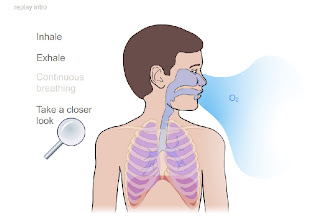download / swf / 238 Kb
The primary force applied in the respiratory tract is supplied by atmospheric pressure. Total atmospheric pressure at sea level is 760 mmHg (101 kPa), with oxygen (O2) providing a partial pressure (pO2) of 160 mmHg (21 kPa), 21% by volume, at the entrance of the nares, a partial pressure of 150 mmHg (20 kPa) in the trachea due to the effect of partial pressure of water vapor, and an estimated pO2 of 100 mmHg (13 kPa) in the alveoli sac, pressure drop due to conduction loss as oxygen travels along the transport passageway. Atmospheric pressure decreases as altitude increases, making effective breathing more difficult at higher altitudes. Higher BPG levels in the blood are also seen at higher elevations, as well.
In similar manner, CO2, which is a result of tissue cellular respiration, is also exchanged. The pCO2 changes from 45 to 40 mmHg (6.0 to 5.3 kPa) in the alveoli. The concentration of this gas in the breath can be measured using a capnograph. As a secondary measurement, respiration rate can be derived from a CO2 breath waveform.
Gas exchange occurs only at pulmonary and systemic capillary beds, but anyone can perform simple experiments with electrodes in blood on the bench-top to observe electric field-stimulated effervescence. Trace gases present in breath at levels lower than a part per million are ammonia, acetone, isoprene. These can be measured using selected ion flow tube mass spectrometry.



0 komentar:
Leave a Reply